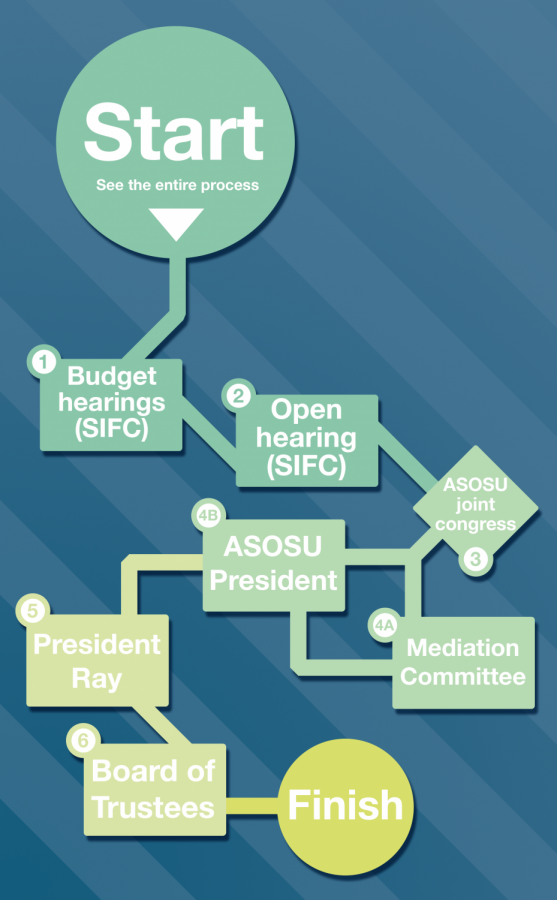The Associated Students of Oregon State University to work with Student Incidental Fee Committee to set student fees for upcoming year
February 22, 2016
SIFC, ASOSU have final student say in fee setting process
The student fee setting process has gone into mediation to decide the fate of dollar amounts going toward three student fee-funded departments.
The joint session hearings between the Student Incidental Fees Committee and the Associated Students of Oregon State University will take place Monday evening to further discuss agreements on proposals for the performing arts, the Student Sustainability Initiative (SSI) and ASOSU’s own budget plan.
One reason the SSI fee was sent to mediation according to discussion at the ASOSU hearing was over concern with the current Night Owl bus transportation service provided by the Corvallis Transit System. Currently student fees pay for the majority of that service.
“The SIFC operates as a recommendatory committee, we have no power to take money specifically from one unit and give to another unit for a specific program,” said Peter Schwartz, the SIFC vice-chair and a junior in finance. “Congress had issues regarding some of the details surrounding the Night Owl contract and for that reason sent the budget to mediation.”
Members of the ASOSU Congress also wanted to take a closer look at the decision to fund Mock Trial within the Performing Arts budget as well, and voted to mediation for this reason.
After going through the SIFC and now ASOSU, the mediation hearing will be the last step of the fee setting process in which students have a direct say in the outcome.
“Currently we are about to enter mediation for three budgets, Student Sustainability Initiative, Performing Arts, and ASOSU,” said Claire McMorris, the SIFC Chair and a junior in political science. “We are hoping to resolve mediation and pass our recommendations up by this week.”
The fee setting process works to set the amount of money students pay per term for fees and decides where the dollars go. The process begins annually with each unit that is funded through student fees working internally to determine a proposed student fee for the next year.
Using their last year’s fee as a base for their next year proposal, units then factors in mandatory increases that factor in non-negotiable cost increases. These mandatories include Operational Pay Expenditures (OPE), as well as inflation and rising building costs.
“It starts with each budgeting unit working with the accountants at the student fee auxiliary business office to create a budget for the next fiscal year, which for universities is the next academic year, so 2016-2017,” McMorris said.
A unit may request an increase in fees on top of the mandatory to help fund new programs, positions, initiatives or any other expense the unit may foresee encountering, which are known as decision packages.
The units then present the proposed fees to the SIFC. These presentations are spread over two days and allow for the SIFC to carefully analyze and question the proposals. The SIFC uses these presentations to make recommendations to each unit about their proposed fees and gain further clarification on each part of the proposed fees.
“The unit will then pass a budget through (in most cases) its student advisory board and then submit the budget, along with certain written responses and explanations, to the SIFC,” McMorris explained.
After the open budget hearings are completed, the process moves into the SIFC open hearing stage, in which each unit presents their final presentations to the SIFC.
The SIFC will then vote to recommend the fee for each individual unit to the be approved by the ASOSU.
“The SIFC will then have a chance to adjust to any changes and reconsider budgets with discretionary increases at the Open Hearing which results in a final recommendation to the ASOSU Congress,” McMorris said.
Once the fees pass pass through SIFC and the levels have been recommended, the ASOSU comes together in a joint congress to vote on each fee. If the fee is approved, it moves on to the ASOSU President to be signed. But if the fee is not approved, it is sent to mediation.
“Most recently we had the joint session where the SIFC presented our recommendation to the ASOSU Congress.” Peter Schwartz , the SIFC vice-chair and a junior in finance explained. “Mediation will allow us to ensure that the correct decision is made.”
The mediation hearing consists of seven members from the SIFC and seven members of the ASOSU, and works to find add further clarification and compromise, and ultimately provides a fee that is approved.
After mediation, the ASOSU President will review the budgets and send them on to the Oregon State University president.
After the OSU president reads over and approves the fees, they go to the Board of Trustees for a more scrutinous examination. Once all questions and concerns are addressed, the Board of Trustees will sign the proposed fees into effect and they will be sent to the Higher Education Coordination Commision or the State Legislature for final approval.
“The Board of Trustees has the ultimate approval in the process of the entire student fee level.”
At this point, the process is complete and the student fee levels for the next year have been set.
Schwartz said this year’s process was different that those in the past, primarily because of the amount of time the SIFC had to work. After an emergency election the end of Fall term, the members had only weeks to come together and start the process. Schwartz has praised this year’s SIFC for their work, especially considering the circumstances surround the emergency election they found themselves in last term.
“Due to some issues within ASOSU last spring, a committee was not elected during the general election,” Schwartz said. “On the whole, our group has meshed incredibly well, especially so considering our substantial time restraints. The group is comprised of some fantastic individuals who all truly care about the students they’re representing,”
Mykael Moore, the ASOSU speaker of the house and a senior in human development and family sciences, spoke to the work SIFC has done, and their collaboration with ASOSU throughout the process.
“SIFC has been in a state of transition since the spring of last year, and the work they do is laborious and intensive,” Moore said.
Moore said the decision to take the three units to mediation rose from the ASOSU’s duty to represent the student body and their best interests.
“We, as ASOSU, have done our best to support SIFC in their process, but we also recognize our place as student leaders within the process.”
According to McMorris, in an effort to protect students from unprecedented increases in tuition and fees, Oregon State legislation statutes ensure that an fee or tuition increase over 5 percent that is approved by the Board of Trustees will have to receive additional approval by the Higher Education Coordinating Commision (HECC), or the State Legislator.
The HECC helps guide Oregon’s public universities and community colleges to make sure the actions of the institutions are in line with state higher education vision and policy.
McMorris, Schwartz and the rest of SIFC have made clear their intention to keep the total student fee increase below 5 percent and remain within the guidelines that have been laid out by the HECC.
“First, it truly is in the best interest of students. We know that the number one concern of students at OSU is college affordability and we want to fight for that,” McMorris said. “Secondly, if we don’t enforce it here, things could get complicated later on. As students we feel that we have the best perspective of the needs and wants for student fees. If we increase over 5 percent that could be left for someone else to cut down the road.”
The SIFC’s recommended student fee increase came in at almost exactly 5 percent. Over 4 percent of that increase, however, came from mandatory increases, McMorris said.
Despite some discrepancies between the SIFC and the ASOSU with the ASOSU fee particularly, and more specifically additional proposed funding for the SafeRide program, Schwartz does not believe that ASOSU is upset with the recommended fee level for ASOSU that came from SIFC. Rather due to the complexities of that scenario, he felt ASOSU believed it would be valuable to send the budget to mediation to take a closer look and ensure that the decision being made has the best interest of students in mind.
“I don’t think it would have been possible to get anything done this year without the collaborative effort between SIFC and ASOSU,” Schwartz said. “An incredible effort was made on both sides to educate the members of congress regarding what we do and how it all works which helped the process run more smoothly.”
According to McMorris, one positive aspect of the process this year was the emphasis on heightened collaboration between SIFC and other units. The SIFC has incorporated a mindset of approaching the fee setting process form a holistic view, which has led to more success than before, McMorris said.
“I felt that the hearing went smoothly, I was incredibly proud of the work that the ASOSU Congress and the SIFC did with all incidental budgets, and especially the work House Appropriations and Budget committee members did,” Moore said. “In my own opinion SIFC and ASOSU has not had any dramatic controversy regarding the fee setting process.”
According to Moore, the mediation will be held today at 6 p.m. in SEC 254, and is open to the public.
























































































































